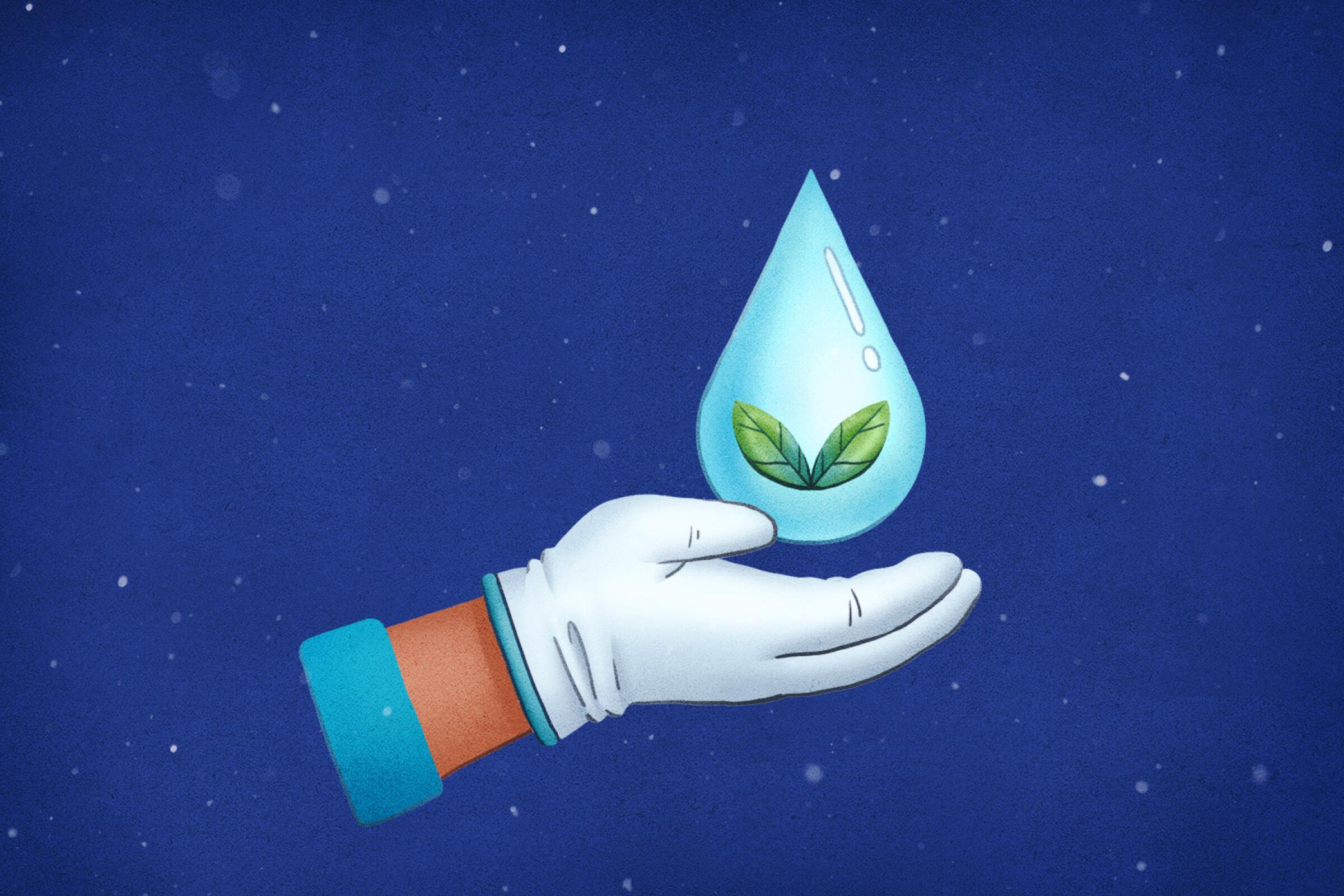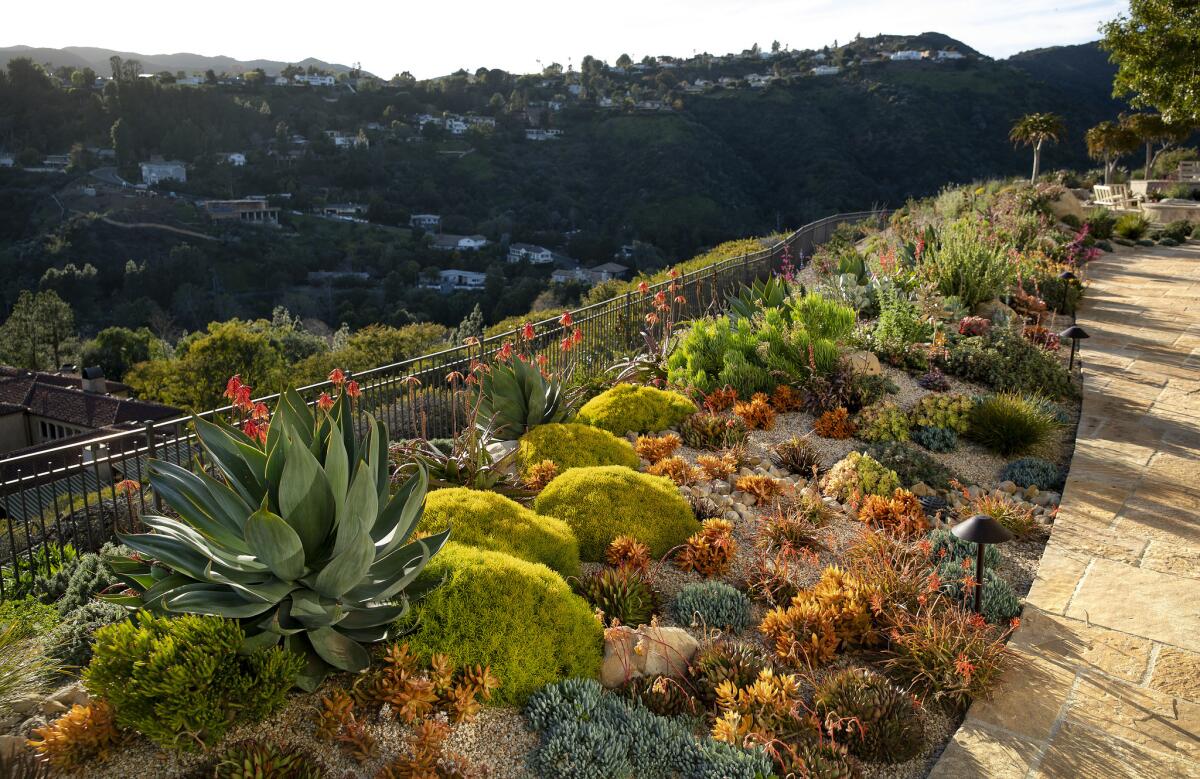Sign up for The Wild
We’ll help you find the best places to hike, bike and run, as well as the perfect silent spots for meditation and yoga.
You may occasionally receive promotional content from the Los Angeles Times.

Xeriscaping (pronounced zer-i-skaping) — literally dry landscaping — is a term coined in the early 1980s by the Denver Water Department combining the Greek prefix for dry (“xero”) with the word “scape,” as in landscape.
The idea was that people living in Mediterranean-type climates (moist winters and dry summers) should landscape with plants suited to dry landscapes rather than plants that need lots of water to survive, said horticulturist Carol Bornstein, director of living collections at the Natural History Museum of Los Angeles County and co-author of “Reimagining the California Lawn” and “California Native Plants for the Garden.”
Unfortunately, the term “xeriscape” quickly became synonymous with austere landscapes.
“It got associated with rocks and succulents, dry, prickly landscapes that aren’t very inviting,” Bornstein said. “It’s not what the word was intended to signify but it’s what a lot of people started doing in terms of landscaping, so it developed a negative interpretation.”
The word has evolved to mean “water-wise,” “California friendly” and the more prevalent “drought tolerant,” which is better, Bornstein said, but still problematic because it sounds as though these are plants needed for unusual drought conditions.
“We have drought every year in California, and it’s called summer,” Bornstein said.
California does have real droughts, such as the 376-week period between Dec. 27, 2011, and March 5, 2019, according to Drought in California, but those are associated with winter rains, or the lack thereof. Regardless of how much rain, summer will be hot so so why not chose plants adapted to those conditions?

“There’s nothing wrong with wanting a lush perennial border, the type the English excel at,” Bornstein said “but for those Eastern, Midwestern and European perennials to do well in Los Angeles, you have to water the heck out of them. My recommendation is to choose different plants. You can still create that garden style; you just have to chose the right perennials for our region.”
Which can be tricky, Bornstein said, because California is a big state. A plant may be labeled a “California native plant,” but that doesn’t make it appropriate for Southern California gardens. For instance, redwoods are native to California “but I don’t recommend people planting them down here,” she said. “They’re as inappropriate here as the water-guzzling plants from the East or Midwest.”
Instead, plan your plants around our Mediterranean climate, which exists not just in Southern California but in the countries that ring the Mediterranean, central Chile, the Western Cape province of South Africa, and southern and western Australia.
Plants native to those regions should fare well in Southern California gardens, but there are good reasons to prefer native plants, she said.
“I’m not a purist, saying everything you plant has to be a California native, but I would try to plant as many native plants as possible, in part to reflect a sense of place,” she said, “but equally important is the habitat value. We’ve lost so much of our natural landscape — not just the plants but the wildlife they sustained — but through our gardens we have the opportunity to help stop the bleeding. We can make a difference in the way that we garden.”
Here are a few tips:
• Take stock of your lawn. Are you using it as a recreational space or is it simply a green carpet? Lawns are relatively easy to maintain, but they require regular water and mowing, which uses gasoline, and create clippings that often end up in landfill. If you really use your lawn, at least consider whether you can make it smaller, creating planting beds for edibles or other low-maintenance, water-saving ground covers, some of which can be walked on like meadow grasses. Change to an electric, mulching lawn mower so the clippings can feed the soil. At a minimum, put your clippings in a compost pile and keep them out of the landfill.
• Visit Southern California’s many botanic gardens to get a good idea about the breadth and diversity of native plants and lawn alternatives, such as the Nature Gardens at the LA County Natural History Museum, the Rancho Santa Ana Botanic Garden in Claremont, devoted to California native plants, the Crescent Farm at the LA Arboretum, which uses lasagna mulching (layering materials) and hugelkultur techniques (raised beds made of woody debris) to transform a compacted old lawn into a garden that flourishes without irrigation. Many of these gardens have nurseries that sell native plants.
• Visit nurseries devoted to California native plants, such as the Tree of Life Nursery in San Juan Capistrano and the Theodore Payne Foundation for Wild Flowers & Native Plants in Sun Valley.
• Invest $17 in the Native Plants for Southern California Gardens flashcards, created by a consortium of Southern California native plant experts to help you plan your garden around 70 of the most popular and easiest-to-find native plants.
• The California Native Plant Society’s Calscape database not only provides photos and descriptors of flowers, shrubs and trees native to your region but also offers the names and addresses of nurseries where you can buy those plants. The society has 35 chapters in California — eight in Southern California alone — so consider attending a meeting to find out more about growing native plants in your region.
Sign up for The Wild
We’ll help you find the best places to hike, bike and run, as well as the perfect silent spots for meditation and yoga.
You may occasionally receive promotional content from the Los Angeles Times.